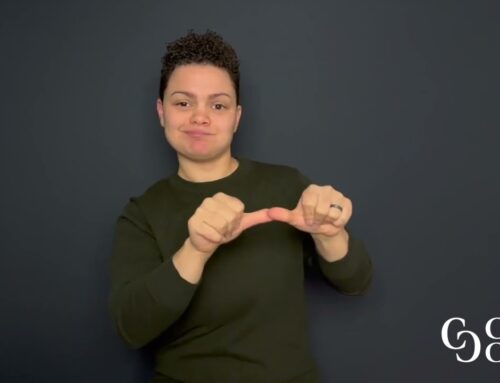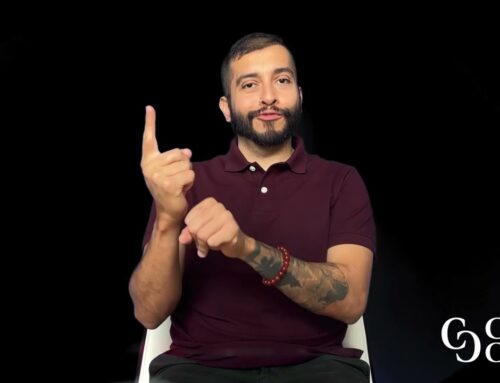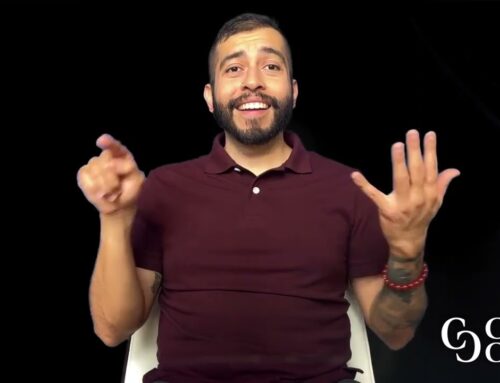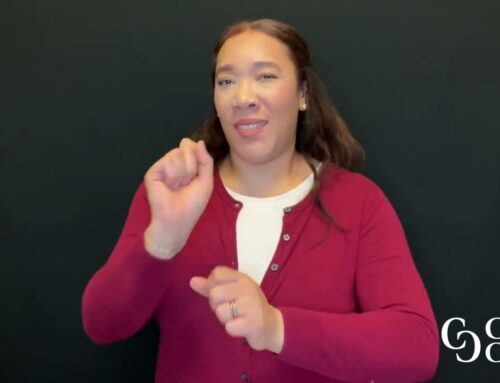Jerrin George moderates a panel discussion on the history of interpreting and RID with the following panelists: Ritchie Bryant, Linda Carroll, Cynthia Napier & Roberto Sandoval.
The initial video slide reads, “Perspectives from Deaf People of Color on the History of Interpreting and RID” Second line reads, “Ritchie Bryant, Linda Carroll, Cynthia Napier & Roberto Sandoval. Moderated by Jerrin George. December 2018.”
Jerrin George’s Visual Description: Indian man with a black patterned background. He is wearing a light blue buttoned-up shirt. He has a short black beard and hair.
Jerrin: I can finally see all five of you on the same screen. With the previous panel, I couldn’t access everyone on my screen. It’s a relief to work with a smaller group. Before I proceed with the second part of the panel, I want to thank every one of you for being willing to stay for the second round. Was there anything from the previous panel that you would like to add that reflects your experience as Black Indigenous People of Color Deaf interpreters within this field? You can either weigh in as a consumer of color or a Deaf interpreter of color.
Ritchie Bryant’s Visual Description: Black male with a dark blue background. He is wearing a grey with a black patterned sweater and black glasses. He has short black/grey hair and black goatee.
Ritchie: I believe Roberto has an important piece of history he should share with all of us.
Roberto Sandoval’s Visual Description: Brown-skinned Chicano with a white wall with white blinds on the left. He is wearing a purple polo shirt. He has short black hair.
Roberto: I’m not sure what you mean. Can you please add some context?
Ritchie: Latinx Deaf history. You did share your thoughts on one of my videos, remember?
Roberto: I have a pressing concern for some time now. I didn’t want to share because it might lead to more unwanted discussion. RID as it currently stands: 1. They don’t have enough interpreters of color serving on the board. 2. I have never, well actually I lied, I’ve only witnessed one interpreter of color serving on the board – Ritchie Bryant. 3. RID raters, I don’t believe I have seen any interpreters of color serve as raters. I think it’s important we take a look at our consumers and the interpreting profession, can our raters understand interpreters of color and their signing styles? Now I want to go back to Ritchie’s point regarding Latinx Deaf interpreters. Latinx Deaf interpreters are often overlooked for skills they can contribute to the profession for example – some Latinx Deaf interpreters know Lengua de señas Mexicana (LSM). LSM is recognized as one of the official languages in Mexico. We have a large consumer base in the United States who use LSM mainly in the southwest area. I also recently learned there is a large number of LSM users living in Wisconsin, Illinois, and a few other states. Sadly it is common for our profession to disregard LSM interpreters as a valuable asset to the profession. Also, I think it’s time we revisit how we structure school systems to ensure we have appropriate Deaf interpreters working in places where there is a high migration point for a certain country or ethnicity to that area. This would ensure accessibility is being considered and properly distributed to where it is needed most to support their language acquisition as part of their transition to the United States. They can pick up on the language within two or three years with appropriate support. How are interpreters supporting the students’ IEP meetings? It’s important we consider cultural and language support to ensure the child has an equal opportunity to participate in their IEP meetings. Sadly, RID hasn’t designed any certification specifically for LSM/ASL interpreters. I think I shared enough for now. I’ll let others share their thoughts.
Ritchie: Can you share one more thing. I recall you telling me about Rafael, one of the trilingual interpreters? Yes, I do feel it’s important you share it with us.
Roberto: Thank you, Ritchie. Ralph Sedono, actually, his parents initially named him Rafael Sedono but unfortunately, their doctor forced them to rename his first name to a more appropriate English name. Rafael is considered the father of trilingual interpreting. ASL/Spanish/English. He also established the first trilingual interpreting training program in Santa Fe Community College in New Mexico. He was also the first Deaf person to run an interpreting training program. “Interpreting training program” is an old term. He didn’t have the opportunity to develop the trilingual interpreting certification which BEI currently has. I’m not sure if RID is planning to support the development of their own certification to support trilingual interpreting work. The training program was running strong until he passed away from a motorcycle accident. After his death, things have gotten quiet and people seem to have forgotten his name. I want to remind everyone that he was the one who pushed for the establishment of the trilingual interpreting profession, training, and certification. Through NCIEC, we established a trilingual interpreting task force to gather information and recognize Rafael as the father of trilingual interpreting. That’s an important part of our history.
Linda Carroll’s Visual Description: Light-skinned native female with a grey background. She is wearing a black shirt, a black pendant, and transparent glasses. She has long white hair.
Linda: I know Rafael back in the old days. I worked with him back in 1996 through the National Multicultural Interpreter Project (NMIP). I even have the program book with me, let me show it to you. We started this project at El Paso Community College. Rafael was focused on working with Latinx interpreters as part of NMIP. I was focused on working with Indian interpreters. Angela Roth was working with Black interpreters, I believe. And we had an Asian female interpreter working with us from Washington DC. I don’t recall her name… Ah yes, Jan Nishimura, she was focused on working with Asian interpreters. It was just four of us and we would work together often through that project. The issues we identified through that project have stayed the same even today. For me as a Native American, I would see white interpreters interpreting at ceremonies. If you think about it, Navjao’s ceremonies are different comparing to Cherokee’s ceremonies, every tribe’s ceremonies are different. White people often think they are qualified to interpret these ceremonies assuming they all are the same, but no, they are not. There are many rules to the ceremonies that need to be honored. For example, if a feather ever lands on the floor in the middle of a ceremony everyone needs to immediately come to a full halt and wait for the elder to approach and bless the piece of land before proceeding with the ceremony. There are many different procedures for different situations within any given ceremony within each tribe. That’s something many interpreters still don’t know about today.
Ritchie: I often think about who the first Black CDI is. We don’t have access to that kind of information. I’m also curious to know more about the history of Deaf interpreters within this field. I do know Cynthia Napier is the current known first black CDI right?
Cynthia Napier’s Visual Description: Black female in a room with kitchen space on the left and a mirror frame on the right above a plant. She is wearing a royal blue shirt and brown glasses and silver earrings.
Cynthia: I think so. I don’t quite remember when I took the test but it was some time ago when I took my CDI exam.
Jerrin: Do you recall the year?
Cynthia: Let me think… I know I did take the exam when RID first released the CDI exam. That was when I took mine, I think it was in 1991, I can’t recall the exact year.
Ritchie: Do you recall who the second Black CDI is? That is a missed opportunity for our community to know who came before us. I’m also curious about… I know Philipheida has… I lost my train of thoughts, I’ll hold it for later.
Cynthia: I’m not sure where to find that information… I don’t even know who else took the exam with me back then. Were there other interpreters of color who took the exam with me? I have no idea. Does RID have this information or where can we find this information?
Ritchie: When I served on the RID board. I did request data on how many certified interpreters of color we have. The main issue is some of the interpreters didn’t opt to self-identify their race/ ethnicity. So when I got the numbers, I knew it was wrong and had to do some digging on my own and followed up with some interpreters to please update their profile accordingly to help us have a better fit data.
Jerrin: I have a question for you Ritchie. Did you have access to archive data from back in the old days?
Ritchie: Let me think… I’m not sure, that’s a good question.
Roberto: I have a question for you Ritchie. Do you think interpreters opt to not self-identify due to a lack of role models within the field to look up to?
Ritchie: That’s certainly a possibility. Lack of role models within the field or they haven’t reached to term with their own racial/ ethnicity identity? Or we haven’t fostered that culture where people can feel comfortable to self-identify. Or we haven’t really established any kind of baseline that feeds the need back to our interpreters for them to self-identify, for example, if we promoted some kind of scholarships or grants specifically designed for interpreters of color to encourage them to update their profile accordingly. We didn’t put much effort into this front. These are several possible factors I can think of.
Linda: I’m thinking back to when I started working with NMIP. We initially wanted to work with Black CDI but we couldn’t find anyone in 1996. We did have Asian, Latinx/Mexican, and Indian CDI. We couldn’t find any Black CDI at the time.
Ritchie: When you said you couldn’t find anyone. Did you mean you couldn’t find any Black CDI or any Black Deaf interpreters?
Linda: We couldn’t find any Black Deaf interpreters. Dr. Mary Mooney searched through multiple networks to see if there were any Black Deaf interpreters working out there in the field. She even worked with RID to tap into their network and we couldn’t find anyone at the time.
Roberto: I want to clarify. The sign for Mexican refers to people who live in Mexico. If you use the sign for Latinx, that should suffice. I’m curious who were you able to identify as a Latinx Deaf interpreter at the time?
Linda: Rafael Sedono and yes, he was also certified with RSC at the time. Yep.
Roberto: I didn’t realize Rafael had RSC. I did some research on his biography and that information never came up. Based on the best of my knowledge the first Latinx interpreter who became certified with CDI is Lillian Garcia Peterkin. Yes, you are correct. Rafael is the first certified interpreter with RSC. Lillian is the first certified interpreter with CDI unfortunately she recently passed away.
Jerrin: I’d like to proceed with the next question. In those conversations about establishing the RID and professionalization of interpreting, were there any BIPOC individuals included as part of those conversations?
Roberto: I a Deaf caucus meeting at RID national conference in Philadelphia in 2009. I was involved as Regional 4 Representative and Vice-Chair of Deaf Caucus. I didn’t recognize my intersectional identities at the time, I only recognized myself as a Deaf interpreter. I did experience several key events at the conference and it hit me some time after that where I started to see myself as not just a Deaf interpreter but a gay, Latinx, Deaf interpreter. I didn’t see any representation of myself within the field.
Ritchie: Based on the photo that was taken at Ball State Teachers College during that time, I don’t see any Black individuals in the photo.
Roberto: I don’t see any affinity group that represents interpreters of color being involved with RID except for Mano a Mano, a trilingual interpreter group. They did a collaboration to explore further on Deaf interpreter’s role within the trilingual interpreting environment. Other than that, I don’t know of any other collaboration partnership.
Jerrin: Thank you. Let me review the list of questions I have with me… Next question. Is there any lingering issue within the interpreting profession from history perspective among white interpreters and interpreters of color?
Roberto: One common misconception white interpreters often have when working with Latinx immigrant consumers is the assumption they have no language. With that assumption, they would shift to using gestuno or drawings. Did it ever occur to them to check in with the consumer to see what language they would prefer to work with? I’ve been asked to educate many agencies to explain to them to always ask and if they identify a language it is the agency’s job to seek out an interpreter with the right language skill to support the job.
Ritchie: Often white Deaf interpreters would consider all consumers as a member of the Deaf community regardless of their intersectional identities. That mentality of we’re all Deaf therefore we’re all the same. It’s important that they learn of different cultural factors that contribute to consumers’ experience working with interpreters.
Linda: I see a lack of diversity within both the hearing and Deaf interpreting profession. That lack of diversity also contributes to not sufficient cultural competence to support the different range of work we do. That’s something we still need to work on. I do feel that Deaf interpreters are still lagging behind compared to hearing interpreters.
Cynthia: Looking back, I see a common issue that keeps coming up within the Deaf community and not so much within the interpreting community. I see frequent resistance from Deaf consumers when it comes to using interpreters of color. “I don’t need a Deaf interpreter” or “Why did you send me a Black interpreter?” I’m not sure if the Deaf community doesn’t have sufficient exposure to talk about race or it’s our skin that triggers their responses toward us. I see fewer issues within the interpreting community but often more within the Deaf community. That was my experience when I entered this field, that level of microaggression from the Deaf community, Ritchie, have you experienced something like this?
Ritchie: Yes. I remember one situation where I worked at a hospital and when the consumer saw me, they immediately said “I don’t want you to interpret for me.” I was taken back and asked what’s wrong. They replied, “You’re black.”. I decided to leave the room and luckily I had a white Deaf interpreter team who advocated for me and assured the consumer that he’s qualified to do the work. After some point, the consumer felt comfortable letting me back in to interpret. After the assignment, the consumer told me, “wow you’re pretty good”. The consumer was quick to judge my work before even seeing it based on the color of my skin. Yes, it’s an unfortunate experience but it doesn’t happen as often as I thought it would.
Jerrin: What conversation within your communities have you had regarding the interpreting profession. Were there any specific barriers or issues that were identified that need to be worked on?
Ritchie: Within Black Deaf communities we’re starting to become more invested and involved within the interpreting community. We have many training out there provided by white interpreters who we can’t really connect with or understand our experience on equal footing. It’s not common for them to be more supportive of our journey and growth within the profession. I provided a workshop at the National Institute of Technology for the Deaf last summer and we had about half students of color. Some of my students came to me and said they finally felt comfortable taking the training with a Black Deaf presenter who can really provide us with the in-depth training they needed in a comfortable space. Some of them even decided to pursue a career in this profession as a result of that experience. They also shared that they often felt belittled by other white interpreter trainers. That’s something we’ve been talking about within our community to push for more Black Deaf trainers to train Black Deaf interpreters so they can lift each other higher.
Linda: Within my communities here, we’re struggling without clear guidance especially since RID placed CDI under moratorium. It has caused many issues and I feel like we’re stuck in limbo and we’re not sure where our profession is going anymore. That’s our current struggle.
Roberto: I know many Deaf interpreters who are proficient in LSM/ASL interpreting work based on their lived experiences. However there isn’t sufficient training provided for example, we do not have enough simultaneous interpreting training out there. Most are already comfortable with consecutive interpreting work. Unfortunately, it doesn’t seem opportunities for training are widely available within the southwest area or near the borders. Most are located outside of the southwest region which means they need to find ways to get the money to travel in order to get additional training. It would be nice if we could develop more training opportunities near the border.
Jerrin: I want to clarify for the record, you used this sign, what does it mean?
Roberto: Border. It’s a sign I borrowed from LSM.
Jerrin: Thank you, Roberto. Next question. From the previous panel, we did address several issues and barriers within the Deaf interpreting field. Are there any additional perspectives specifically from BIPOC communities that you would like to weigh in with? This is an open-ended question. Sure, I can rephrase my question. From the previous panel, we did identify several issues and barriers that are commonly encountered within the Deaf interpreting field. I’m curious to hear more from all of you as members of the BIPOC community, do you feel there are additional perspectives on these issues and barriers that were not previously discussed?
Ritchie: As I mentioned earlier regarding conflict and barriers. It’s common for interpreters of color to find themselves alone in a room full of white participants when taking interpreting training. It’s often that they feel burdened to represent the community they are tied to and it’s awkward to participate if one needs to juggle with that expectation. I think it’s important we strive to create more spaces for interpreters of color to be with each other and hopefully big enough for them to feel free to be themselves. We also need to revisit different structures within testing provisions and entry points at training programs to see if we could identify any potential barriers for interpreters of color.
Roberto: One of the biggest challenges and barriers I can think of is the recruitment of interpreters to serve on RID’s task forces. The majority of Deaf interpreters who are certified are white. So how can we recruit more Deaf interpreters of color as part of the taskforce if they are not certified? There are many things we need to address before we can do the next thing and other things we need to resolve before we can even go back and proceed with this. There are many moving connected parts.
Jerrin: I believe RID currently allows any RID members to join the taskforce or do they need to be certified as well?
Ritchie: It depends on which group we’re talking about. We did have some members who served on certification committees who are not certified. For example, when NAD and RID collaborated on a project, NAD secured several representatives to work with the certification committee. Some of these members are not certified. So it really depends on which group we’re talking about, some do require members to be certified and some don’t. It’s possible they are intentionally recruiting members to represent consumer perspective only, that’s when RID will not require the person to be certified.
Roberto: For example, when I worked with NCIEC as part of their trilingual interpreting task force as a trainer. We agreed to have half Deaf and hearing members on the taskforce and proceed to develop criteria for applicants to become members of the taskforce. I had to remind them we actually do not have that many Latinx Deaf interpreters who are certified. We ended up expanding the criteria to include RID, BEI, state interpreter licensure, or a letter of recommendations from two certified Deaf interpreters. These alternatives were added to the criteria to ensure we do not add more barriers in the process. It was a challenge to figure out how to arrive at a good balance of what will work best based on the numbers of Latinx certified interpreters we currently have.
Jerrin: Thank you all for joining us as part of this panel discussion. I’m honored to have you join us for the entire hour and 45 minutes. Thank you for allowing us to document history based on your experience and perspective within this profession. This will benefit me and many other new Deaf interpreters who will access this recording within Graduation to Certification’s library. Thank you all for your time! Good night everyone.
The closing screen reads, “St. Catherine University. CATIE Center. For more resources, visit grad2cert.org. The St. Catherine University CATIE Center, Graduation to Certification project is funded by US Department of Education, Rehabilitation Services Administration, #H160C160001. Although the contents of this video were developed under a grant from the Department of Education, these contents do not necessarily represent the policy of the Department of Education, and you should not assume endorsement by the Federal government.





